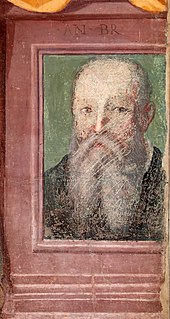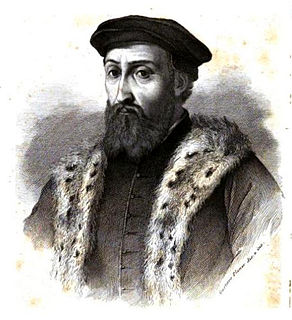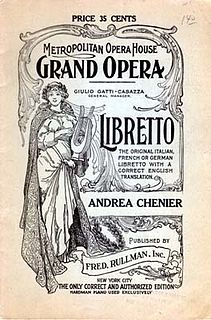
Lorenzo de' Medici was an Italian statesman, de facto ruler of the Florentine Republic and the most powerful and enthusiastic patron of Renaissance culture in Italy. Also known as Lorenzo the Magnificent by contemporary Florentines, he was a magnate, diplomat, politician and patron of scholars, artists and poets. As a patron, he is best known for his sponsorship of artists such as Botticelli and Michelangelo. He held the balance of power within the Italic League, an alliance of states that stabilized political conditions on the Italian peninsula for decades, and his life coincided with the mature phase of the Italian Renaissance and the Golden Age of Florence. The Peace of Lodi of 1454 that he helped maintain among the various Italian states collapsed with his death. He is buried in the Medici Chapel in Florence.

Cosimo di Giovanni de' Medici, called "the Elder" and posthumously "Father of the Fatherland", was an Italian banker and politician, the first member of the Medici political dynasty that served as de facto rulers of Florence during much of the Italian Renaissance. Despite his influence, his power was not absolute; Florence's legislative councils at times resisted his proposals throughout his life, and he was always viewed as primus inter pares rather than an autocrat. His power derived from his wealth as a banker, and he was a great patron of learning, the arts and architecture.

Giovanni di Bicci de' Medici was an Italian banker and founder of the Medici Bank. While other members of the Medici family, such as Chiarissimo di Giambuono de' Medici, who served in the Signoria of Florence in 1201, and Salvestro de' Medici, who was implicated in the Ciompi Revolt of 1378, are of historical interest, it was Giovanni's founding of the family bank that truly initiated the family's rise to power in Florence. He was the father of Cosimo de' Medici, the first Medici ruler of Florence, and an ancestor of other notable Medici rulers, for example, the grandfather of Piero di Cosimo de' Medici; great-grandfather of Lorenzo de' Medici ; and great-great-great-grandfather of Cosimo I de' Medici, Grand Duke of Tuscany.

Florence Cathedral, formally the Cattedrale di Santa Maria del Fiore, is the cathedral of Florence, Italy. It was begun in 1296 in the Gothic style to a design of Arnolfo di Cambio and was structurally completed by 1436, with the dome designed by Filippo Brunelleschi. The exterior of the basilica is faced with polychrome marble panels in various shades of green and pink, bordered by white, and has an elaborate 19th-century Gothic Revival façade by Emilio De Fabris.

Cosimo I de' Medici was the second Duke of Florence from 1537 until 1569, when he became the first Grand Duke of Tuscany, a title he held until his death.

Agnolo di Cosimo, usually known as Bronzino, or Agnolo Bronzino, was an Italian Mannerist painter, born in Florence. His sobriquet, Bronzino, may refer to his relatively dark skin or reddish hair.

The Teatro della Pergola is a historic opera house in Florence, Italy. It is located in the centre of the city on the Via della Pergola, from which the theatre takes its name. It was built in 1656 under the patronage of Cardinal Gian Carlo de' Medici to designs by the architect Ferdinando Tacca, son of the sculptor Pietro Tacca; its inaugural production was the opera buffa, Il potestà di Colognole by Jacopo Melani. The opera house, the first to be built with superposed tiers of boxes rather than raked semi-circular seating in the Roman fashion, is considered to be the oldest in Italy, having occupied the same site for more than 350 years.
Rinaldo degli Albizzi (1370–1442) was an Italian nobleman, a member of the Florentine family of the Albizzi. Together with Palla Strozzi, he was the main opponent of Cosimo de' Medici's rise in Florence.

San Giovanni dei Fiorentini is a minor basilica and a titular church in the Ponte rione of Rome, Italy.

Filippo Strozzi the Younger was a Florentine banker, and the most famous member of the Strozzi family in the Renaissance. He is best remembered as a tragic hero and defender of the lost Florentine republic against the Medici dukes – yet this is almost entirely a nineteenth-century fiction of nationalist historians and dramatists. He had been one of the staunchest supporters of the Medici in Florence and Rome.
Among several members of the extended Florentine patrician family the Cavalcanti holding the name Giovanni, the chronicler Giovanni Cavalcanti (1381-c.1451), of a minor branch of the family but who was captain of the Guelf party in 1422, is most widely remembered for his malevolent and melancholic account of Florence, covering the period 1420-47. Cavalcanti's Storie obsessively focussed on the city's political intrigues and scandals and was colored by his personal political misfortunes as an aristocratic agitator, first against the corrupt oligarchy of 1420-34 and subsequently of the Medici; his long imprisonment for debt excluded him from the participation in public life that he considered his noble right.
Lorenzo the Elder was an Italian banker of the House of Medici of Florence, the younger brother of Cosimo de' Medici the Elder and progenitor of the so-called "Popolani" ("commoner") line of the family, named for a later generation whose members were supporters of the Florentine political activist Girolamo Savonarola.
Il Trespolo tutore is a comic opera in three acts by the Italian composer Alessandro Stradella with a libretto by Giovanni Cosimo Villifranchi. It was first performed at the Teatro Falcone, Genoa on 30 or 31 January, 1679. It is considered one of the first Italian comic operas.
Frank (Anthony) D'Accone is an American musicologist. D'Accone is the author of pioneering documentary studies of the musicians and institutions that produced the music of the Florentine and Siennese Renaissance. His many modern editions of the music of this culture made available to present-day performers and scholars for the first time in several centuries a full and wide-ranging picture of the musical life in Tuscany during the Renaissance. His body of work “substantially extends current knowledge of the music history of the Italian Renaissance.”
Andrea Salvadori was an Italian poet and librettist. He was born in Florence and educated at the Collegio Romano in Rome. From 1616 until his death in Florence at the age of 43, he was the principal court poet to the Medici family. In addition to numerous theatrical entertainments and poems, he wrote the libretti for five operas, four of which have survived, although only La Flora composed by Marco da Gagliano and Jacopo Peri has an extant score. He was married twice, first to Emilia Rigogli by whom he had three sons and then to the painter Alessandra Furini. A collection of Salvadori's principal works curated by his son Francesco was published in 1668.

Bindo Altoviti (1491-1557) of the House of Altoviti was one of the most influential papal bankers of his generation and patron to the arts cultivating close friendships with artists as Vasari, Cellini, Raphael and Michelangelo

Medici: Masters of Florence is the first season of the Italian-British television drama series Medici about the Medici dynasty set in 15th-century Florence, starring Dustin Hoffman as Giovanni di Bicci de' Medici, Richard Madden as Cosimo de' Medici, and Stuart Martin as Lorenzo de' Medici. The series was co-created by Frank Spotnitz and Nicholas Meyer. Sergio Mimica-Gezzan directed all eight episodes. Episodes 1 and 2 aired on Rai 1 on 18 October 2016. According to Italian ratings compiler Auditel, it attracted a record 7.6 million viewers. The first season consists of eight episodes.

Alessandro Felici was an Italian composer and violinist, not to be confused with his contemporary, Roman composer Felice Alessandri.
Antonio Altoviti was an Italian Catholic archbishop, son of Bindo Altoviti and archbishop of Florence from 1548 to 1573.
Giovanni Maria Pagliardi (1637–1702) was an Italian composer. He became de facto maestro di cappella at Florence Cathedral from 1690, but did not formally gain the title till the death of his predecessor, Pietro Sammartini.













